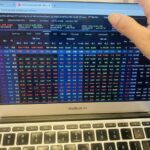Gold prices fell on Wednesday (Aug 28) as the US dollar strengthened ahead of a crucial US inflation report this week – data that could influence the Federal Reserve’s interest rate decision. One analyst commented that after reaching record highs recently, gold prices are unlikely to enter a deep decline as they did in 1979 and 2011.
At the close of New York trading, gold for immediate delivery fell by $19.80/oz from the previous session’s close, equivalent to a 0.78% drop, to $2,505.10/oz, according to data from the Kitco exchange.
Over 7 am Vietnamese time on Thursday (Aug 29), the price of immediate gold in Asia rose by $9.10/oz compared to the US close, equivalent to a 0.36% increase, trading at $2,514.20/oz. Converted at Vietcombank’s selling rate, this price is equivalent to about VND 75.8 million/troy ounce, down VND 300,000/troy ounce from yesterday morning.
Gold prices faced downward pressure as the Dollar Index, which measures the strength of the US dollar, rose 0.6% to close at 101.09 points, according to data from MarketWatch.
The US dollar has been consistently losing value recently due to the possibility of an upcoming Fed rate cut, with the Dollar Index falling to a near two-year low this week. This has been an important supporting factor for gold prices to maintain the key $2,500/oz level.
“The gold market is under selling pressure as the US dollar recovers. At this point, we are waiting for more information to determine a specific direction for gold prices. That information is inflation data,” said David Meger, director of precious metals trading at High Ridge Futures.
Mr. Meger said many investors took profits ahead of the Personal Consumption Expenditures (PCE) price index report, which will be released by the US Department of Commerce on Friday. PCE is the Fed’s most important inflation measure, and this report could determine how much the Fed will cut interest rates at its September meeting.
According to senior analyst Ricardo Evangelista of ActivTrades, if the upcoming PCE report shows weaker-than-expected figures, investors will increase bets on a more dovish Fed stance. For example, the Fed could cut interest rates by 0.5 percentage points instead of 0.25 percentage points on Sept 18. In that case, gold prices would have an opportunity to break out.
Currently, the market is betting on a 65.5% chance that the Fed will cut interest rates by 0.25 percentage points in the first cut next month and a 34.5% chance of a 0.5 percentage point reduction, according to data from the CME exchange’s FedWatch Tool.
According to data from the World Gold Council (WGC), global gold exchange-traded funds (ETFs) bought a modest 8 tons of gold, worth $403 million, last week, led by funds in North America. Chinese customs data released on Tuesday showed that net gold imports into mainland China through Hong Kong rose 17% in July from a year earlier.

In an analysis published in the Jerusalem Post, expert Tim Zyla said that the current record gold price could be sustainable, unlike in 1979 and 2011 – years in which gold prices peaked and then entered a period of decline of at least 50%.
“In the past 50 years, gold prices have peaked twice, in 1979 and 2011. The difference with the 2024 peak is that it has broken out of the trend line connecting the previous two peaks,” Zyla wrote in the report.
The expert suggested that the main question now is whether the new record high in gold prices should be considered a bullish or bearish signal.
Zyla pointed out that the gold price increases in 1979 and 2011 were driven by specific geopolitical and economic shocks. For 1979, it was the crisis originating from the Middle East, and for 2011, it was the US government’s bailout of banks due to the risks they posed to the financial system. Once these events and risks were resolved, the upward momentum of gold prices faded, and gold prices quickly fell from their record highs.
Meanwhile, he argued that the current gold price rally is different because “there is no specific major risk event driving gold prices up,” and this will make gold prices less likely to fall. “While short-term adjustments are inevitable, there are hardly any factors indicating that gold prices will not sustain their upward trend, as the Fed has signaled a rate cut,” Zyla said.
Choose stocks for “Tet” festival celebrations
Investors should consider choosing stocks in the banking industry with good profitability, healthy real estate, and abundant clean land reserves. In addition, the group of stocks in infrastructure investment, iron and steel, and construction materials should also be considered.
‘King of spenders’ Phan Minh Thong warns of ‘shocking’ changes in the US market from a $500,000 pho bowl perspective.
“In the US, a bowl of pho costs about $15-18, plus a $20 tip (around 500,000 Vietnamese dong). Compared to Vietnam, where breakfast in Saigon or Hanoi costs around 50,000 dong per meal, and a plate of banh cuon with all the toppings in Hai Phong costs 20,000 dong,” Mr. Thong recounted.







































